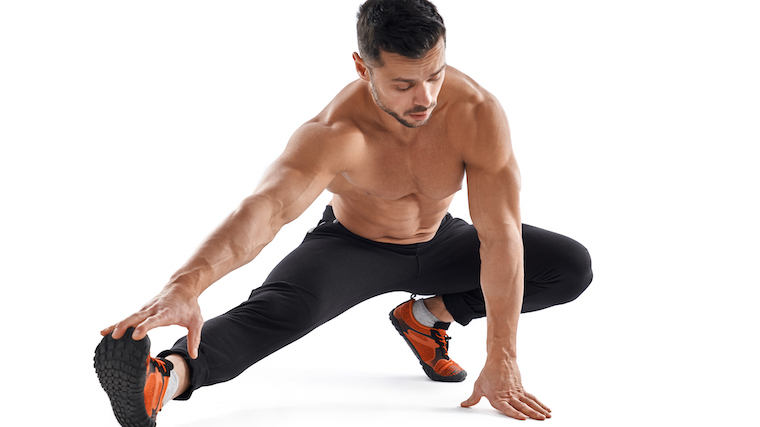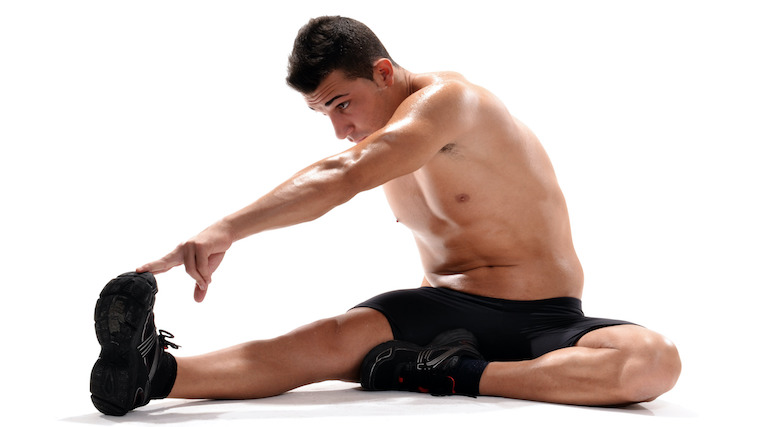Developing a yoga practice isn’t just about hopping onto your yoga mat every Sunday. It’s about the kind of deep stretching that you need to engage in regularly if you want to be a healthy, injury-free strength athlete. If you’re the type that avoids stretching because it can feel oddly emotional, that might be all the more reason to unroll your mat and get to work.
Editor’s note: This article is an op-ed. The views expressed herein and in the video are the author’s and don’t necessarily reflect the views of BarBend. Claims, assertions, opinions, and quotes have been sourced exclusively by the author.

There is a powerful emotional and mental component to stepping onto the lifting platform and putting in a max effort. All things being equal, if your training and recovery has been on point, whether you succeed or fail at putting up your best numbers depends heavily on your mental and emotional state. Strength athletes often welcome that emotional turmoil, seeking the calm in the center of setting up for a big lift — but we also tend to run from the emotions released by deep stretching.
Intense Stretching Promotes Emotional Release
Whether you’re trying to open your hips, your chest, or stretch your shoulders, it can get pretty emotional when your stretching that goes beyond a few casual swings of the arms or a quick lunge or two. It might not even register as emotion at first. It might just feel like a deep, disquieting sense of profound discomfort. But once you can identify what’s going on in your mind when you’re stretching, it can be easier to stay engaged.
The payoff to stretching through the emotional barriers and achieving emotional release is not only less tension, it’s also less sadness, according to the Journal of Behavior Therapy and Experiment Psychiatry (1).
Emotions Might Be Why You Avoid Stretching
Have you ever sank into a deep hip flexor stretch after a day of heavy deadlifting and found yourself desperately rushing through it — or stopping completely — because that sensation of discomfort just got… too much? If you’re a strength athlete, you might relish physical discomfort, but when it comes to stretching, it takes many of us by surprise and we run from it, often avoiding deep stretching altogether.
We expect, perhaps, intense emotions from our big lifts, but we don’t prepare for stretching the same way. Yet that discomfort when you get really deep into your hips…definitely might elicit an emotional response that makes you want to pull back and stop completely.

As a strength athlete, you’ll likely know the difference when you feel it — stretching your hamstrings might feel tedious and cause your muscles some discomfort, sure. But then, when you get really deep into your hips, all bets are off. Your heart might start racing and your brain might even start to panic, even though — for all intents and purposes — your body is doing a lot less physical work than it was a few minutes ago when you were squatting heavy.
You might get jittery and feel a deep desire, almost a need, to stop the stretch or to make it less intense, even if your muscles themselves seem fine. It may well be intense emotional sensations creeping up on you while you stretch — but don’t worry, you’re not the only one who experiences them.
Why Is Deep Stretching So Emotional?
When was the last time you had a good sobbing session, rolling into a fetal position on your bed? Or, maybe the last time you curled up for a horror movie while hugging your popcorn and your knees super close to your chest. It’s pretty instinctive for many humans to curl up and make ourselves smaller — specifically, to bring our knees up in front of our torsos (where so many of our vital organs live) — when we feel sad or scared.
Trauma is stored throughout our bodies, and it’s natural to want to curl up and protect ourselves from feeling that trauma. Deep-seated emotional distress can make it that much harder to sink into the stretches that, as a strength athlete, you should be doing.
Hip Stretches Release Emotional Tension
Think about your hips’ involvement in movements that require a squat or hip hinge: your hip flexors have to shorten to get you there. Consider also that you may well sit all day, most days, keeping your hips further locked up. So what happens when you open your hips? Often…emotional overflow.

[Related: 5 Things Mentally Strong Lifters Avoid]
Whether you want to call it mechanical tension, emotional stress, or both, your body likely holds tension in your hips. It makes a lot of sense, then, that hip-opening stretches especially can cause emotions to burst forward in a bit of a panicked outpouring. If shortening your hip muscles is what you do when you’re tense, stretching them can help release that tension.
Chest Openers Can Be Very Vulnerable
A similar emotional release can occur when you open your chest and stretch through your shoulders and upper back. Think about the way you’re positioned right now: is your jaw clenched? Your shoulders tensed? Your chest slightly collapsed in on itself? If the answer is yes, it stands to reason that when you stretch your upper body, you’re letting that residual tension go. This tension release is an emotional and vulnerable process, especially with your throat and chest more exposed than normal.
How Can You Stretch When It’s So Emotional?
Different people hold tension differently in their bodies. For some, hip openers are by far more intense than chest openers. For others, it’s the other way around, or some other combination entirely.

[Related: 3 Coaches Share Their Favorite Active Stretches for Strength Athletes]
The first step to figuring out how to stretch through the emotions is acknowledging that the process can be an emotional whirlwind.
Ask Questions
Get curious about what’s going on for you. Are you feeling sad? Overwhelmed? Excited? Scared? Panic is actually pretty common, whether you’re in a big group during yoga class or doing an intense lizard stretch all on your own in your gym’s stretching area.
Pull out of the stretch when you need to, of course, but try to breathe into it when you can. Remind yourself that you will not, in fact, die if you hold the stretch just a little longer (though it might feel like that sometimes).
Modify And Breathe
Perform less intense modifications of the stretches that trigger the most emotions for you, and gradually increase their intensity over time. With each inhale, make your body a little longer; and with each exhale, try to sink just a little bit deeper into whatever stretch you’re doing. That will keep your mind and breath actively engaged, so that the feelings won’t feel so sudden and out of nowhere.
Prepare Mentally
For lifters especially, it’s important to gear ourselves up for stretching. It can be easy to think, “okay, the hard part is over,” when you’ve finished your lifts, but you’ll create a whole new level of mental toughness if you actively and intentionally engage in the emotional journey of stretching, as well.
Try to not let deep stretching take you by surprise. You expect intense emotions when you’re about to max out on the platform, so you’re usually not taken aback or scared by doing so — the same goes for stretching.
[Related: What’s the Difference Between Passive and Active Stretching?]
Try preparing similarly for stretching and see what a difference bracing yourself mentally can make. Remember that the more effectively you stretch, the more effective your lifts will be.
Stretch Through It
Whether we want to think of it this way or not, lifters are emotional creatures. Integrating stretching — even and especially when it gets emotional — into your practice is only going to make you a more mentally fit athlete.
References
- C.R. Carlson, et al. Muscle stretching as an alternative relaxation training procedure. (1990). Journal of Behavior Therapy and Experiment Psychiatry. doi: 10.1016/0005-7916(90)90046-n
Featured image via Shutterstock/mavo